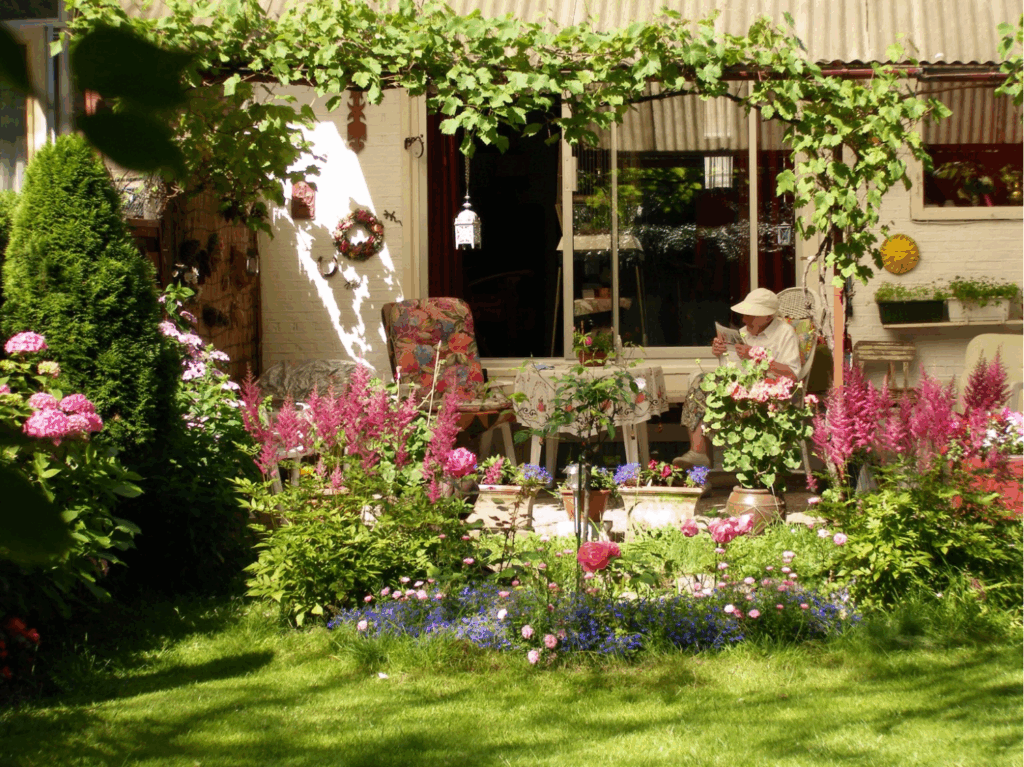Introduction
Dementia and Alzheimer’s disease affect millions worldwide, with their defining symptoms being memory loss, confusion, and emotional distress. While medical treatments focus on slowing cognitive decline, non-pharmacological interventions have gained recognition for directly improving the quality of life of people living with dementia. An example of non-pharmacological intervention would be dementia gardens, which are specially designed outdoor spaces that engage the senses, evoke memories, and provide a calming environment for individuals with cognitive impairments.
What Are Dementia Gardens?
Dementia gardens, also called memory gardens or sensory gardens, are outdoor spaces tailored to the needs of individuals living with dementia. They incorporate elements that stimulate all five senses while ensuring safety and accessibility.
Key Features of an Effective Dementia Garden:

- Safety First
- Smooth, non-slip pathways (avoid gravel or uneven surfaces)
- Clearly marked exits to prevent wandering and confusion
- Secure fencing to ensure a contained, safe space
- Sensory Stimulation: which is important for neuroplasticity and helps with memory retention and learning.
- Visual (Sight): Bright flowers that easily catch people’s attention, such as marigolds and sunflowers
- Olfactory (Smell): Lavender, rosemary, mint, jasmine
- Tactile (Touch): Lamb’s ear (soft leaves), bark textures, smooth stones
- Auditory (Sound): Wind chimes, water features, bird feeders
- Taste (Edible Plants): Strawberries, cherry tomatoes, herbs
- Familiarity & Memory Triggers
- Vintage-style benches, old-fashioned flowers (like roses or daisies)
- Vegetable patches (if the person previously enjoyed gardening)
- Repetition of plants to reinforce recognition
- Comfort & Accessibility
- Shaded seating areas for rest
- Raised garden beds for wheelchair users
- Gentle slopes instead of stairs
Let’s Look at Evidence
Research supports the profound impact of nature on people living with dementia:
1. Reduces Agitation & Anxiety
- Nature’s calming effect lowers cortisol (stress hormone) levels. This reduces stress and encourages more positive thoughts.
2. Improves Cognitive Engagement
- The Montessori Method for Dementia uses sensory gardens to stimulate memory recall through familiar smells and textures. This method was developed by Dr. Maria Montessori, who placed emphasis on independence.
- A 2018 study in Health Environments Research & Design Journal found that dementia patients in garden settings showed improved attention and communication. When visiting dementia gardens with those who are living with dementia, we are able to point out specific elements of the scenery, which encourages conversation.
3. Encourages Physical Activity
- Light gardening tasks (watering, picking flowers) promote motor skills and gentle exercise.
- Walking on even pathways helps maintain mobility.
4. Enhances Social Interaction
- Gardens provide a natural setting for family visits and group activities.
- Caregivers report better engagement with patients in outdoor spaces.
How to Build a Dementia-Friendly Garden
Step 1: Assess Space & Safety
- For Home Gardens: A small patio or backyard can be adapted.
- For Care Facilities: Larger spaces with looping pathways prevent confusion.
- Safety Checks:
- Remove toxic plants (e.g., foxglove, oleander).
- Ensure gates are secure but not locked (for emergency access).
- Remove wires and other hazards from pathways.
Step 2: Choose the Right Plants
It is incredibly important to choose the correct plants, as each plant has different benefits. Plants can be broken down into 4 different types, such as fragrant, textured, colorful, and edible. Below are some examples of the benefits that plants may have within dementia gardens.
- Fragrant Plants: Lavender, rosemary, mint (calming, memory-triggering scents)
- Textured Plants: Lamb’s ear, succulents (tactile stimulation)
- Colorful Plants: Marigolds, pansies (bright hues aid visual recognition)
- Edible Plants: Strawberries, basil (safe for tasting, encourages activity)
Step 3: Incorporate Sensory & Memory Elements
- Water Features: A small fountain or birdbath provides soothing sounds.
- Wind Chimes & Bird Feeders: Encourage auditory engagement.
- Memory Lane: A pathway with personalized items (old gardening tools, family photos).
Step 4: Ensure Accessibility
- Raised Beds: At waist height for easy access.
- Wide Pathways: Minimum 4 feet wide for wheelchairs/walkers.
- Seating: Benches every 20-30 feet for resting.
Step 5: Engage the Person Living with Dementia
- Let the person participate in simple tasks such as watering or picking herbs.
- Use the garden for reminiscence therapy
- Try by asking basic questions such as “Do you remember growing tomatoes?” or “Do you remember the taste of a banana?”
- Then move on to questions that involve more conversation, such as “Can you tell me about a time when you grew tomatoes?”
Conclusion
Dementia gardens are more than just beautiful landscapes. They are therapeutic tools that enhance well-being, reduce stress, and reconnect individuals with fading memories. Whether in a care facility or a backyard, these gardens offer a holistic approach to dementia care, blending nature, science, and compassion. By incorporating safety, sensory stimulation, and familiarity, we can create spaces that bring comfort, joy, and moments of clarity to those living with dementia.
Sources:
